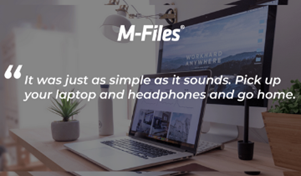Streamlining Autodesk Deployments: How CQi Simplifies the Installation Process
For many organisations, Autodesk software is mission-critical — used daily across design, engineering, and construction teams.

We're pleased to share this blog post from our partner M-Files
 Earlier this year the whole world was faced with a new reality and suddenly, efficient remote work became a critical business enabler. In March, we here at M-Files were faced with the exact same reality as the rest of the world. There was an instantaneous need to pack up the laptop and start working remotely from home.
Earlier this year the whole world was faced with a new reality and suddenly, efficient remote work became a critical business enabler. In March, we here at M-Files were faced with the exact same reality as the rest of the world. There was an instantaneous need to pack up the laptop and start working remotely from home.
But that was not a problem. It was just as simple as it sounds. Pick up your pc and headphones and go home. Literally.
What made it so easy for us?
Well, we naturally use M-Files, a document and drawing management software solution, as our tool for content storage, processing, and collaboration. So when setting up our home office environments, no setup work was actually needed. We only needed our laptops, internet access and access to M-Files. M-Files ensures that we have all information available regardless of where we work from. Whether that's a home office or any other location with internet access — a coffee shop, a co-working space, a client location, wherever.
If we need to share files between M-Filers or with externals, we don't need to worry about using a vulnerable private file sharing tool. Or if we need to continue working with a document someone created earlier, we don't need to worry about the latest version being somewhere in our email inbox or on a shared drive with intermittent access to virtual private networks (VPN). With our document and drawing management software M-Files, we all have access to the document, and there is always only one common version of any document. No version chaos. No different versions in emails, in network drives, or on anyone's C-drive. Everything is stored in M-Files, and we all have access to the documents based on our role — and based on our need to see or edit something.
With all content managed in M-Files, we also have the added benefit of automated workflows that support our processes. Getting comments, or approval, from one or several colleagues is easy and efficient, and the version history of the file will also store the steps in case anyone needs to confirm the process later.
What about challenges along the way?
We haven't faced any challenges really, it's been smooth sailing. However, we do miss the face-to-face interaction with our colleagues even though most of us are based in Finland where social distancing is in fact part of the culture. Fortunately, the use of video in our online conference calls have increased quickly which helps with this downside.
What about our customers?
We have also been able to help our customers deploy remote workforces as quickly as we were able to do it.
Jen Dingmann, Systems Analyst Manager at Stearns Bank N.A describes their adjustment to the new reality of work as follows:
"As a national bank, our staff and operations are centralized at our head office and physical branches throughout the US. As a long-time M-Files customer, we've been able to seamlessly transition to a virtual work environment without skipping a beat. We have also recently been able to quickly automate new business processes with M-Files to address the rapidly accelerating Paycheck Protection Program loan application volume. This has been an invaluable asset in delivering on our promise of helping customers with a sense of urgency and accountability."
If you are interested in learning more about how to deploy a remote workforce quickly with document and drawing management software, take a look at our webpage.
For many organisations, Autodesk software is mission-critical — used daily across design, engineering, and construction teams.
Cybercriminals are always evolving, and so should your defences. This month, we shine a spotlight on three often-overlooked yet critical security concerns that could put your business at risk.
A well-designed archiving solution ensures the long-term integrity, accessibility, and compliance of project information - preserving critical records while mitigating risks. In this blog post, we explore why data archiving is no longer optional, but essential, and introduce ArchiveHub
